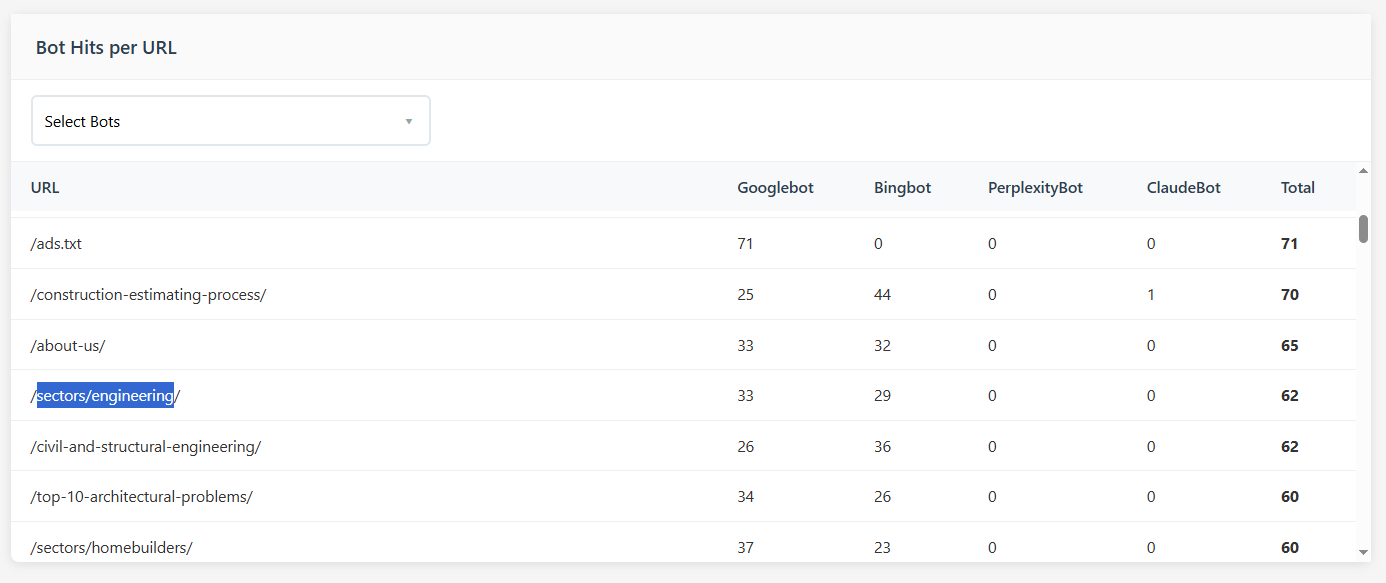Understanding Bot Traffic in Your Server Logs
What Is LLM Bot Traffic?
LLM bot traffic refers to visits from large language model bots such as ChatGPT, Bing AI, Claude, or Perplexity. These bots crawl websites to gather content for training or to answer live user questions. They appear in server logs under user-agent names like GPTBot, ChatGPT-User, ClaudeBot, or PerplexityBot.
Unlike Googlebot, which indexes for search rankings, LLM bots are designed to power AI responses. They rarely show up in Google Analytics because they do not execute the JavaScript that triggers tracking. Server logs, however, record their activity. One site recorded 490 ChatGPT-User requests hitting 167 pages, while Analytics showed only three user sessions during the same time.
Why Are AI Bots Visiting My Site?
As people increasingly use conversational AI, bots fetch web content to provide answers. GPTBot scrapes pages to improve ChatGPT, while ChatGPT-User retrieves live information when someone asks a relevant question. Similar behavior occurs with Claude and Perplexity.
This matters because crawlability influences whether your site appears in AI answers. If bots cannot access your content, you risk being excluded from responses that users may rely on instead of search results.
The activity also impacts performance. Some sites find that OpenAI's crawlers hit their pages far more often than Googlebot. One study showed ChatGPT bots requesting pages twelve times more frequently than Google. Heavy crawling can consume bandwidth and affect hosting costs.
How Can I Identify LLM Bot Traffic in Server Logs?
Server logs list every request. To spot AI bots, look at user-agent strings. Examples include:
- Mozilla/5.0 (compatible; GPTBot/1.0; +https://openai.com/gptbot)
Other identifiers include ChatGPT-User, ClaudeBot, or PerplexityBot.
Patterns also reveal them. Bots often fetch many pages in bursts, including old or low-traffic content. They may ignore crawl-delay settings and request at unusual hours. Crucially, their visits do not appear in Google Analytics, which helps confirm they are automated.

Log file analysis helps you quickly filter and summarise this traffic — click here to try it out and see the full guide.
What Are the SEO and Analytics Implications?
For SEO, LLM bots create new exposure channels. Your content can appear in AI-generated answers, sometimes with citations or links. This extends reach but may reduce clicks, since users may get the information directly from the AI. It resembles Google's featured snippets, but on a larger scale.
If competitors' content is used while yours is not, you risk losing visibility. Monitoring logs helps you see which pages bots fetch and whether they align with your target topics.
In analytics, separating bot traffic from human visits is essential. If not filtered, server log spikes may look like user growth. Update filters to exclude bot user-agents so engagement metrics remain accurate. Some referral traffic may come from AI interfaces like chat.openai.com when users click citations, so keep an eye on referral reports.
What Should I Do About LLM Bot Traffic?
Monitor and Interpret Logs
Review logs regularly to see how bots interact with your site. Repeated errors or failed requests may indicate that bots cannot access content. Fixing technical issues like slow loading or hidden text can increase the chance of being cited in AI results.
Filter Analytics
Keep AI traffic separate in reports. Ensure filters or segments exclude user-agents such as GPTBot and ChatGPT-User, so human engagement data stays reliable.
Decide on Access
You can allow or block bots depending on your goals. Allowing GPTBot or ClaudeBot increases the chance of being referenced in AI answers. Blocking may conserve resources or protect sensitive content. Robots.txt directives can restrict access, and OpenAI confirms GPTBot respects them. Cloudflare or firewall rules can limit overactive crawlers.
Before blocking, consider the trade-off. As Aleyda Solis notes, if you opt out, competitors' content may be used instead. Many businesses choose to allow reputable AI crawlers while blocking suspicious scrapers.
Optimize for AI Readability
Technical SEO best practices apply here. Ensure content loads quickly, avoid hiding key text behind JavaScript, and use clear HTML structure. Structured data such as FAQs and product details helps both search engines and AI bots interpret your site.
Concise, factual writing also works well, since AI prefers clear answers to questions. Maintaining updated FAQ sections or direct explanations can improve your chances of being referenced.
Conclusion
LLM bots like GPTBot, ClaudeBot, and PerplexityBot are now routine visitors in server logs. They represent both opportunity and challenge: new visibility in AI platforms, but also extra load on your servers and new measurement complexities.
For SEO professionals, the priority is awareness. Monitor logs, separate bot activity from human traffic, and decide strategically which bots to allow. Optimise content so AI systems can access and interpret it.
These bots signal the shift toward AI-driven discovery. Understanding and adapting to their presence ensures your content continues to reach audiences - even when those audiences are reading through an AI assistant rather than clicking directly to your site.
Related Articles
Complete Guide to Server Log Analysis for SEO
Learn how to analyze server logs to identify crawl issues, optimize crawl budget, and improve your site's SEO performance.
Top SEO Trends to Watch in 2025
Discover the latest SEO trends and algorithm updates that will shape search engine optimization strategies this year.